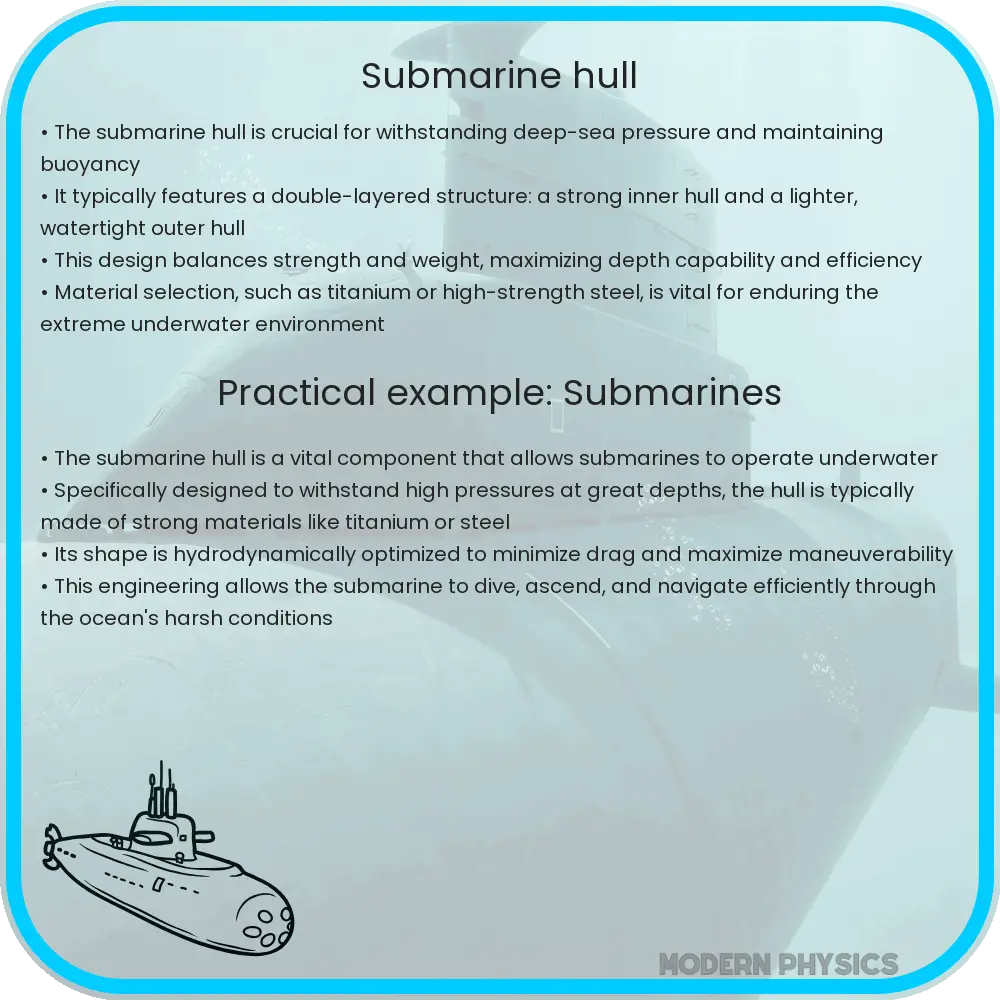Explore the intricacies of submarine hull design, focusing on buoyancy, stability, and pressure resistance, enhanced by advanced materials and tech.

Understanding Submarine Hull Design: Balancing Buoyancy, Stability, and Pressure
Submarine hull design is a complex and fascinating area of naval engineering, encompassing aspects of buoyancy, stability, and pressure resistance. These elements are crucial for the safe and efficient operation of submarines, whether for military, research, or recreational purposes. This article delves into the science and engineering principles underlying these key aspects.
Buoyancy: The Archimedes Principle at Work
Buoyancy, the force that enables a submarine to float or submerge, is governed by the Archimedes Principle. This principle states that the upward buoyant force exerted on a body immersed in a fluid is equal to the weight of the fluid displaced by the body. In simpler terms, a submarine must displace a volume of water equivalent to its own weight to stay afloat. When a submarine wants to dive, it takes in water to its ballast tanks, increasing its weight and decreasing its buoyancy. Conversely, expelling water from these tanks makes the submarine lighter and increases its buoyancy, allowing it to rise.
Stability: Keeping the Balance Underwater
Stability in submarine design refers to the ability to maintain an upright orientation and resist rolling or pitching motions. This is achieved through careful distribution of weight and buoyancy centers. The center of gravity, located low in the submarine, must align closely with the center of buoyancy, ensuring that any tilting force is counteracted effectively. Additionally, the use of fins and control surfaces aids in maintaining directional stability and maneuverability.
Pressure Resistance: Withstanding the Depths
As a submarine dives deeper, the water pressure around it increases significantly. At great depths, the pressure can be immense, necessitating a strong and resilient hull design. Submarine hulls are typically constructed with high-strength steel or titanium, shaped into a cylindrical or spherical form to evenly distribute the external pressure. These materials and shapes are chosen for their ability to withstand compression without buckling or fracturing. Advanced computational tools and hydrodynamic modeling are employed to optimize the hull design for specific depth ratings and operational requirements.
In conclusion, the design of a submarine’s hull is a delicate balance of buoyancy, stability, and pressure resistance. Each aspect is interdependent and must be carefully considered to ensure the vessel’s safety, efficiency, and performance. The next section will explore further details of these design elements, including material selection and technological advancements.
Material Selection and Technological Advancements in Submarine Hull Design
The selection of materials for submarine hull construction is critical to achieving the desired balance of buoyancy, stability, and pressure resistance. Historically, submarines were made from variants of steel, which offered a good combination of strength and flexibility. Modern submarines, however, often utilize high-strength steel alloys or even titanium. These materials provide greater resistance to corrosion and fatigue, critical factors in the longevity and safety of the submarine.
Advancements in Hydrodynamic Efficiency
Advancements in computational fluid dynamics (CFD) have revolutionized the field of submarine hull design. These tools allow engineers to simulate the behavior of submarines under various conditions, leading to designs that are more hydrodynamically efficient. This efficiency translates to reduced noise levels, a critical factor in military applications, and improved speed and maneuverability.
Pressure Resistance: Beyond Material Strength
Beyond the choice of material, the structural integrity of a submarine is paramount. The hull must be designed to withstand not only the immense pressures at depth but also to endure the stresses of rapid pressure changes during dives and ascents. Advanced welding techniques and structural reinforcements, such as ribs and frames, are employed to ensure the hull’s integrity under these demanding conditions.
Future Trends in Submarine Design
Emerging technologies are poised to further revolutionize submarine design. The integration of artificial intelligence (AI) and autonomous systems is expected to enhance operational capabilities and safety. Additionally, there is a growing focus on sustainable designs, incorporating more energy-efficient propulsion systems and environmentally friendly materials.
Conclusion
The design of a submarine’s hull is a multifaceted engineering challenge, intricately balancing buoyancy, stability, and pressure resistance. Advances in material science, computational modeling, and technology continue to push the boundaries of what is possible in submarine design. As we move forward, these innovations promise to deliver submarines that are more efficient, safer, and capable of exploring the ocean’s depths like never before. The evolution of submarine hull design remains a testament to human ingenuity and our unending quest to conquer the challenges of the deep sea.
